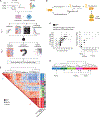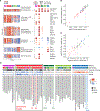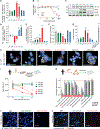FALCON systematically interrogates free fatty acid biology and identifies a novel mediator of lipotoxicity
- PMID: 37075753
- PMCID: PMC10257950
- DOI: 10.1016/j.cmet.2023.03.018
FALCON systematically interrogates free fatty acid biology and identifies a novel mediator of lipotoxicity
Abstract
Cellular exposure to free fatty acids (FFAs) is implicated in the pathogenesis of obesity-associated diseases. However, there are no scalable approaches to comprehensively assess the diverse FFAs circulating in human plasma. Furthermore, assessing how FFA-mediated processes interact with genetic risk for disease remains elusive. Here, we report the design and implementation of fatty acid library for comprehensive ontologies (FALCON), an unbiased, scalable, and multimodal interrogation of 61 structurally diverse FFAs. We identified a subset of lipotoxic monounsaturated fatty acids associated with decreased membrane fluidity. Furthermore, we prioritized genes that reflect the combined effects of harmful FFA exposure and genetic risk for type 2 diabetes (T2D). We found that c-MAF-inducing protein (CMIP) protects cells from FFA exposure by modulating Akt signaling. In sum, FALCON empowers the study of fundamental FFA biology and offers an integrative approach to identify much needed targets for diverse diseases associated with disordered FFA metabolism.
Keywords: CMIP; GWAS; erucic acid; kidney; lipidomics; microglia; obesity; pancreatic β cell; transcriptomics; type 2 diabetes.
Copyright © 2023 The Author(s). Published by Elsevier Inc. All rights reserved.
Conflict of interest statement
Declaration of interests N.W., J.C.F., and A.G. are co-inventors of a patent on the composition, method, and use for FFA screening, application no: 52199-550P01US. A.G. serves as a founding advisor to a new company launched by Atlas Ventures, an agreement reviewed and managed by Brigham and Women’s Hospital, Mass General Brigham, and the Broad Institute of MIT and Harvard in accordance with their conflict of interest policies.
Figures







Update of
-
FALCON systematically interrogates free fatty acid biology and identifies a novel mediator of lipotoxicity.bioRxiv [Preprint]. 2023 Feb 20:2023.02.19.529127. doi: 10.1101/2023.02.19.529127. bioRxiv. 2023. Update in: Cell Metab. 2023 May 2;35(5):887-905.e11. doi: 10.1016/j.cmet.2023.03.018. PMID: 36865221 Free PMC article. Updated. Preprint.
References
Publication types
MeSH terms
Substances
Grants and funding
- R01 DK125490/DK/NIDDK NIH HHS/United States
- P30 DK040561/DK/NIDDK NIH HHS/United States
- R01 DK095045/DK/NIDDK NIH HHS/United States
- R01 DK099465/DK/NIDDK NIH HHS/United States
- F30 DK112477/DK/NIDDK NIH HHS/United States
- S10 OD026839/OD/NIH HHS/United States
- T32 GM007753/GM/NIGMS NIH HHS/United States
- K00 DK123834/DK/NIDDK NIH HHS/United States
- F31 DK126252/DK/NIDDK NIH HHS/United States
- T32 GM144273/GM/NIGMS NIH HHS/United States
- R01 DK126855/DK/NIDDK NIH HHS/United States
- R35 GM122547/GM/NIGMS NIH HHS/United States
- UM1 DK126185/DK/NIDDK NIH HHS/United States
- P50 HD105351/HD/NICHD NIH HHS/United States
- T32 GM007216/GM/NIGMS NIH HHS/United States
LinkOut - more resources
Full Text Sources
Medical
Molecular Biology Databases

